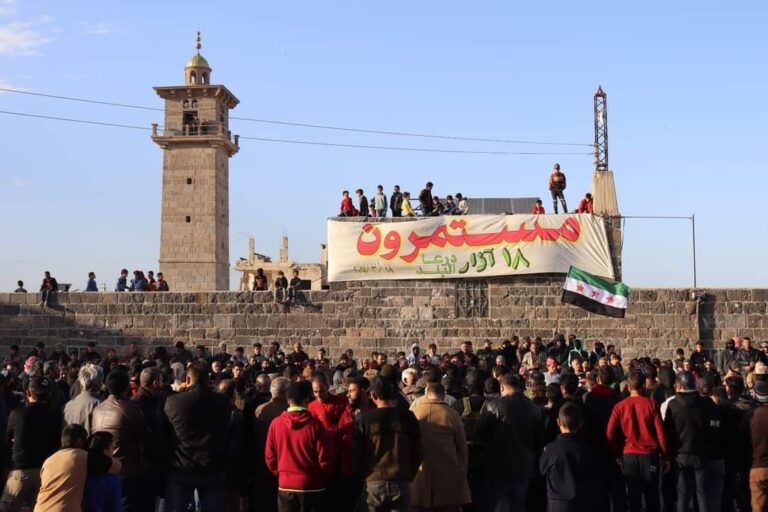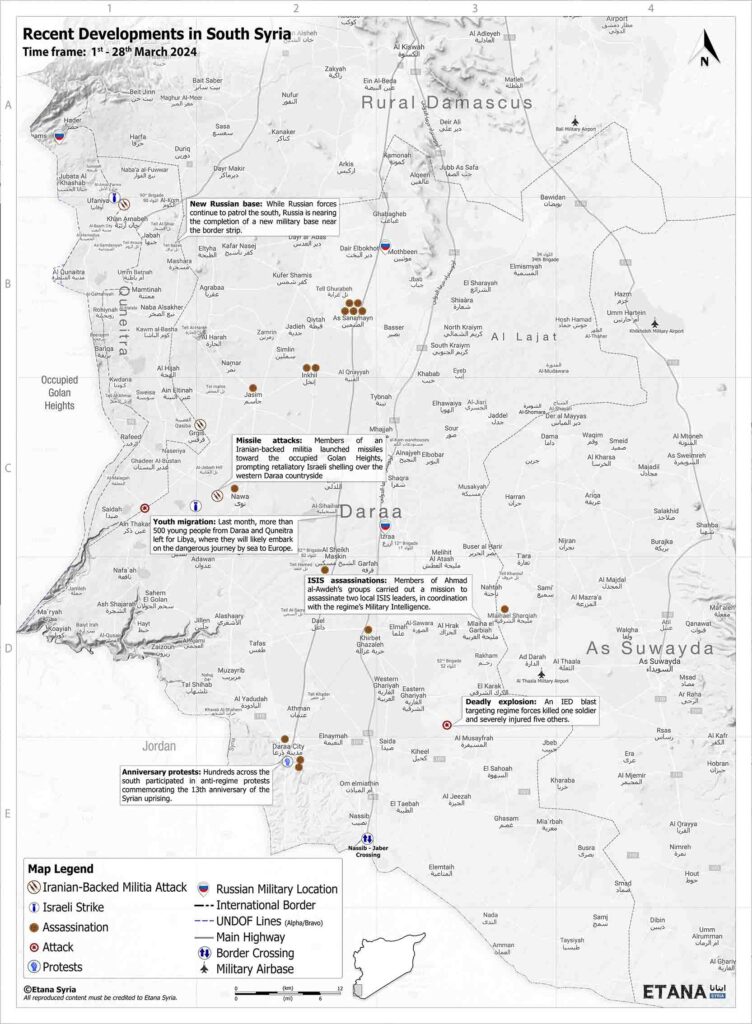The conflict between Iranian-backed militias and Israeli forces in south-west Syria has slowed in recent weeks. Just three missile launches by militias targeting the border strip with the occupied Golan Heights were recorded last month, followed by relatively muted retaliatory strikes from Israeli forces. At the height of the tensions back in October and November, Iranian-backed militias in the south were launching rockets almost every 24 hours.
In Quneitra, a new Russian military base is nearing completion. When finished, it should amplify Russia’s military presence near the border and support Moscow’s claims of relevance in the south-west—even though it has been unable to halt cross-border attacks by Iranian-backed militias operating in Syria.
March also marked the 13th anniversary of the Syrian uprising. Demonstrations against the Assad regime took place across the south on 15th & 18th March, the two dates most associated with the 2011 protests. Hundreds of protesters came out in over 20 locations in the south, a remarkably high turnout due to threats of violence and arrests from regime authorities.
Conflict with Israel
The simmering conflict between Israeli forces and Iranian-backed militias in south-west Syria has quieted for the time being, with cross-border exchanges of fire at their lowest point since the outbreak of hostilities in Palestine and the broader region last October. Around that time, Iranian-backed militias were launching rockets nearly every 24 hours, compared to just three attacks in the month of March. No casualties or significant material damage were reported. In several retaliatory strikes, Israeli forces shelled locations along the Jasim-Nawa road and elsewhere in western Daraa. The strikes resulted in no casualties.
Pro-Regime Activity
Russian forces continue to perform routine patrols across eastern Daraa and northern Quneitra, seeking to bring a sense of security to the region and calm cross-border tensions between Israeli forces and Iranian-backed militias. Russian military aircraft were later observed flying over Daraa province, marking the first such activity in weeks.
Additionally, Russian forces are nearing the completion of their new military base in Quneitra, meant to significantly bolster Russia’s presence in south-west Syria. This development follows growing indications that Israel has stopped sharing forewarnings of its attacks on Syrian territory with Russian commanders inside Syria—part of a longstanding deconfliction mechanism between the two countries.
Regime forces have continued to conduct narcotics search operations around farms in the eastern Daraa countryside. No arrests or drug seizures were made, suggesting the regime is only engaging in performative anti-smuggling operations. Facing renewed sanctions and international isolation, the Assad regime relies heavily on its profits from the cross-border trade of Captagon and other illicit substances.
Ahmad al-Awdeh Affiliated Activity
The longstanding rivalry between Ahmad al-Awdeh’s groups and regime Military Intelligence near Al-Musayfrah sharply escalated in late March, culminating in a series of tit-for-tat kidnappings and armed clashes between members of the two sides that eventually prompted a larger armed incursion by al-Awdeh’s groups. On 23rd March, members of al-Awdeh’s forces launched an operation into the town, expelling Military Intelligence units and pushing back against the expanding reach of Military Intelligence’s influence in the area between Busra al-Sham and Daraa.
Al-Awdeh’s forces remain active in combating the smuggling trade and ISIS cells in the south-west: last month, the group carried out a series of raids in eastern Daraa, arresting one known smuggler. Earlier in the month, his forces also killed two ISIS members in an operation that took place between eastern Daraa and western Suwayda.
Instability in South Syria
Endemic levels of societal violence, as well as frequent attacks against regime forces and other local authority figures, continue across south Syria. Amidst an overall security vacuum, myriad clashes between armed groups, local clan disputes and assassinations against a range of figures have resulted in a tense and precarious security environment.
There has been a sharp rise in IED attacks targeting regime forces in recent weeks, particularly a string of deadly blasts in early March across the western Daraa countryside. In total, eight IED attacks struck regime vehicles, killing at least nine soldiers and wounding more than 24 others. Notable individuals and regular civilians also continue to be frequently targeted by assassinations across south-west Syria, with 15 people killed last month.
Humanitarian Developments
18th March is traditionally commemorated as the start of the Syrian uprising, and hundreds took to the streets in more than 20 locations across south Syria, despite the deployment of regime police in public spaces and threats from authorities warding against participation. Other smaller protests took place in Daraa city leading up to the date. Notably, Suwayda, marking eight months since the beginning of its own anti-regime movement, commemorated the occasion, though the Druze community in the province largely did not participate in the nationwide 2011 protest movement. Protesters across the south-west continued to demand the downfall of the Assad regime, and increasingly for the removal of Hezbollah and Iranian proxy forces from Syria.
The beginning of the spring human smuggling season has begun in the central Mediterranean, ushering in a period that has historically seen far higher levels of attempted sea crossings from Libya as well as deaths from maritime accidents along the route. More than 500 young people from Daraa and Quneitra departed from Libya in March, five times the total from the previous month.
It is expected that more than 8,000 young people from south Syria will attempt the dangerous crossing in the coming months. Many are pushed to leave due to deteriorating economic and social conditions in the region. After more than 100 young people from Daraa drowned in one incident last June, these so-called “death boats” have become symbolic of the immense risks Syrians are willing to expose themselves to in order to flee the country.







